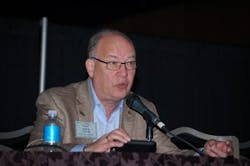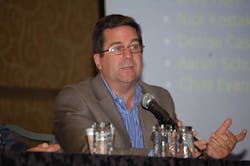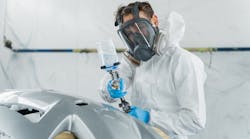From the courtroom to the aluminum “clean room,” 2016 is shaping up to be another year of change and drama for the collision repair industry. New laws will go into effect, new vehicle technology will roll into shops and new insurer and vendor practices are expected to play a role in the day-to-day business of shops.
As 2016 begins, here’s our annual preview of what to look for in the coming year.
Two-tier shop licensing begins
The industry this year will get its first look at how a two-tiered shop licensing program can work as a new Rhode Island law goes into effect this month. The legislation segments collision repair facilities as "Class A" or "Class B," based on equipment and training levels. It also requires that insurance companies conduct labor rate surveys to determine "separate and distinct" prevailing labor rates for the two classes of shops.
The law stipulates that a Class A facility: must be certified by at least one auto manufacturer for the repair and refinishing of aluminum, high-strength steel and other metals; must provide a written limited lifetime warranty against workmanship defects; must maintain a system for documenting customer complaints and responses; and must provide evidence of certification of all technicians employed at the facility.
For insurers, the new law has very specific requirements for the annually required labor rate survey process, though it does allow insurers to consider factors in addition to the survey when establishing prevailing rates for each classification of shop.
Jina Petrarca-Karampetsos of the Auto Body Association of Rhode Island, which backed the new law, expects that less than 15 percent of the approximately 200 shops in the state will initially qualify as Class A. But she said the association is working to find ways – such as bringing in group training – to help shops more affordably meet the “Class A” requirements.
“It’s in everyone’s interest to get up to this level,” she said. “Any shop that doesn’t get itself ready in the next 5-10 years is not going to be in business. As we told our membership, we’re giving you the incentive to get on this now, to keep yourself competitive.”
Number and severity of claims to rise
For collision repairers bombarded with news about new accident-avoidance technology, here’s some good news: Analysts at the Big Three estimating system companies don’t think that will hurt the industry in the short-term. Across the board they are not predicting decreases in 2016 in the number and bottom-line price of collision repair jobs.
Rick Tuuri of AudaExplore is perhaps the most guarded, suggesting that the number of claims “will remain flat to up slightly in 2016.” He expects the slight rise in report costs seen in 2014-2015 also to continue in 2016.
Greg Horn of Mitchell International says as long as fuel prices will remain low, that will more than offset any decrease in claims counts from accident avoidance technology. With new-car sales reaching record numbers, he said, “the number of insured vehicles on the road will increase and pull the average age to a newer model year, and with that (will come) an increase in severity.”
Susanna Gotsch of CCC Information Services gives her predictions a “Back to the Future” twist, saying 2015 numbers were more like the pre-recession peak of 2007 than those of the 2008-2014 period. While longer-term demographic trends – including aging drivers – and vehicle technology changes point to an eventual decline in accident frequency, she doesn’t expect those trends to show up in 2016.
“In the near-term, with miles driven up across the U.S., and gas prices low, frequency will like continue to see moderate growth in 2016 and 2017, before the industry really begins to see the impact of the crash avoidance technology,” Gotsch said.
She noted Mother Nature is also doing collision repairers a favor with recent increases in the frequency and severity of hailstorms.
Gotsch also said repair costs also are growing at a rate comparable to what they were pre-recession.
“New materials and growing complexity of newer vehicles are adding to the mix,” she said. “The industry saw increases in repair costs overall across all vehicle ages between 3 percent and 4 percent in 2015, and will see a potentially slightly larger increase in 2016.”
Total losses on the rise
Analysts across the board also seem to agree that the percentage of vehicles declared total losses will rise in 2016 – they just vary a bit by how much they think that increase will be.
“With the vehicle fleet and claims data currently concentrated around the newest and oldest vehicles, total loss frequency has risen and will likely remain elevated through 2016,” Gotsch said. “In fact, vehicles 15-years-plus have seen the largest growth in volume share – and given the market value for these older vehicles, it doesn’t take much damage until the vehicle is deemed a total loss.”
Tuuri said he thinks the biggest hit from total losses came in 2014, when the percentage of totals jumped 16 percent, likely caused by downward pressure on used car values as new-car sales finally began rebounding in earnest. As 2015 was ending, Tuuri said the increase in total losses was looking to be half what it was the prior year, so about 8 percent. He’s predicting a similar rise in 2016.
Horn, however, is predicting a bigger spike in total losses in 2016 than in recent years, likely a full percentage point. He cites much the same reason as Tuuri for the increase: New-car sales suppressing used-car values.
More aluminum repair – but still not a lot
Knowing that the historically best-selling vehicle in America is now an aluminum-intensive vehicle, it’s easy to imagine a glut of aluminum repair work flooding into shops. But even the aluminum industry, which champions the growing role the material is playing for the automakers, say repair volume will be modest in 2016.
Speaking at the Society of Collision Repair Specialists’ “OEM Collision Repair Technology Summit” last fall, Doug Richman of Kaiser Aluminum shared some projections that extended out to 2025. For 2016, his numbers showed, approximately 69,000 aluminum-intensive vehicles like the Ford F-150 will need collision repair work. That may sound like a lot until you spread that work out among what he estimates will be about 4,000 body shops equipped and trained to do aluminum repair work in 2016. It means an average of just 17 aluminum-intensive vehicles per shop, barely more than one per month.
The numbers are a little more encouraging when vehicles with just aluminum closures (doors, hoods or decklids) are added to the mix. Richman projects there will be about 681,000 of those coming into shops in 2016. It seems unlikely that all of those will roll into the 4,000 aluminum-ready shops, though if they did, that’s an average of 169 jobs in 2016 for each of those shops.
In any case, Richman said, the numbers aren’t staggering.
“This isn’t taking over your business,” Richman said of aluminum repair. “This is just going to be a segment of your business.”
Study will look at danger of aluminum dust
In other aluminum-related news for 2016, I-CAR is involved in some research into safety issues related to aluminum dust.
Richman said concentrations of aluminum dust do pose an explosion risk, but I-CAR is working to determine the potential level of that threat within the collision repair environment.
“There is a hazard, but it’s really, really rare to have a combustible problem in a plant,” Richman said. “The only places we’ve ever encountered a difficulty with the dust hazard have been in very high volume production facilities that were not properly managed. I don’t think there’s been an incident in decades in the United States. There have been some overseas. But these were in facilities that were polishing hundreds of wheels every hour, all day long. That can create quite a cloud of dust. That’s where we see the problem. But we don’t ever want to make a mistake and not respect the potential risk. So we want to do some work to understand what’s the real risk in your shop environment for this dust hazard.”
He said the end-result in 2016 will be a bulletin focused on the aluminum dust particle size and concentrations found in collision repair facilities, to give shops what they “need to know to be sure you’re safe, your employees are safe and your shop is safe.”
More consolidation – but how much?
A year ago, it seemed in the realm of possibility that a multi-shop operation (MSO) might end 2015 having 500 shops. But despite a non-stop flurry of acquisitions, that milestone wasn’t achieved – and it’s not a given it will happen in 2016 either.
For several years, two franchise operations, Maaco and Carstar, each with about 450 shops, have the closest to that milestone. But neither is growing nearly as quickly as what are often called the “Big 4” MSOs: The Boyd Group (which operates in the United States as “Gerber Collision & Glass”), ABRA Auto Body & Glass, Caliber Collision and Service King.
But as of late 2015, none of these Big 4 had yet topped the 400-shop mark, and all would have to have their largest year of growth ever to reach 500 in 2016. With the number of mid-sized MSOs dwindling (because of previous acquisitions), the Big 4 will increasingly have to grow though acquisition of smaller operations, often individual shops, rather than 10- 20- and 30-shop chains. That could slow their speed of progress toward the 500-shop mark.
On the other hand, all it would take would be for any two of these Big 4 to merge to instantly create a 500-shop MSO and the single biggest player in the industry. A few industry analysts think that could happen – but more seem to think each of the Big 4 will just continue to each add 50 to 100 shops in 2016, keeping them each just shy of 500 shops at the end of the year.
Legal dramas continue to play out
Lawsuits against insurers by shops around the country dominated much of the news in 2014 and 2015. As 2016 begins, the shops in the legal boxing ring haven’t suffered a complete knock-out, but have certainly taken some tough blows.
At one point there were about two dozen such lawsuits in about 20 states in which shops (and in some cases their trade associations) accuse insurers of conspiring to manipulate labor rates and other shop charges to reduce costs.
All, at some point last year, were dismissed in whole or in part by the U.S. District Court in Florida where all the cases have been consolidated. In most of the suits, the shops chose to refile amended lawsuits, adding more details about insurers’ behavior and working to address legal short-comings the court found in portions of the lawsuits.
But by year’s end, at least a half-dozen of the suits had been dismissed entirely or were dropped by the shops involved. The dismissals of others were under appeal. And in many of the cases, one side or the other (or both) are seeking sanctions (in the form of attorneys’ fees) from the other.
2016 will likely see either the demise of the rest of these suits – or the end of the summary judgment portion of the process (in which the suits can be dismissed early on) and a move toward preparing for a trial that wouldn’t come before 2017.
Will other automakers follow GM on parts pricing?
General Motors has now rolled out its MyPriceLink system, which does away with static retail list pricing for crash parts in favor of more flexible “real-time pricing,” designed to help the automaker compete with non-OEM parts. The system, first announced in November of 2014, was delayed a year while GM worked to integrate the system with the estimating systems.
How much impact it will have on shops, insurers or parts vendors (OEM or non-OEM) isn’t entirely clear. But many in the industry suspect other automakers will be watching it closely in 2016 to decide if they want to follow GM’s lead. It will be interesting to watch whether the change impacts shops’ parts choices or profits.
Those trends – and the outcome and fall-out from many of these items to watch for this year – will likely be more clear by the end of 2016.





